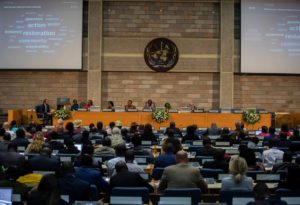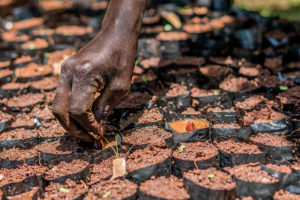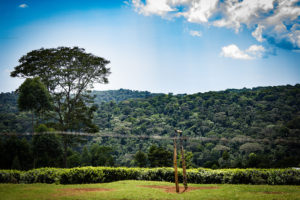
Every year, Africa loses 2.8 million hectares of forest, which is an area roughly the size of Saudi Arabia. Meanwhile, two-thirds of its land is degraded.
However, as countries mobilize to restore 100 million hectares by 2030 in the African Forest Landscape Restoration Initiative (AFR100), local communities are emerging as a driving force behind the movement to recover the continent’s landscapes.
Communities and collaborators across sectors and governance levels have taken center stage at the Global Landscapes Forum – Prospects and Opportunities for Restoration in Africa (GLF). The two-day event, in which several CGIAR Research Program on Forests, Trees and Agroforestry (FTA) scientists participated, ran from Aug. 29-30 and attracted 800 delegates to UN Environment headquarters in Nairobi, Kenya, as well as 30,000 people online.
“If landscape degradation brings huge costs to society and restoration brings impressive returns, why we are not implementing it?” queried Robert Nasi, director general of the Center for International Forestry Research (CIFOR), at the opening plenary.
Land degradation is estimated to cost the global economy up to $4.5 trillion a year, while economic benefits of restoration are an estimated $84 billion a year. In Africa, soil and nutrient depletion on cropland costs 3 percent of gross domestic product.
Watch: Robert Nasi’s opening remarks at GLF Nairobi 2018
These factors combined lead Nasi to believe it is time for a paradigm change: “from seeing restoration as a high-cost activity with no financial returns to landowners and with only environmental benefits, to one which provides increased incomes to landowners, creates jobs, and results in ecosystem goods and services for society as a whole.”
PEOPLE AND PLANET
UN Environment head Erik Solheim pointed out the 17 UN Sustainable Development Goals (SDGs) boil down to delivering benefits for both people and the planet. “To meet the SDGs we need policies that are good for the jobs, the climate, and nature at the same time. Landscape restoration does just this,” he said.
Solheim reaffirmed his commitment to El Salvador’s proposal for a UN Decade of Ecosystem Restoration 2021-2030. “The process must be led by member states, so please support El Salvador in this great endeavor,” he urged. The same period might also be devoted to rangelands and pastoralism, further increasing momentum to reclaim healthy landscapes.
Restoration can bring back ecosystem services and landscape functionality, boost agricultural productivity and enhance resilience to climate change – but it can also have even greater benefits, said Ina-Marlene Ruthenberg, country manager for Zambia at the World Bank.

“The sustainable use of natural resources leads to improved livelihoods, greener economies and food security, while bringing peace, security and stability. Restoring landscapes contributes to preventing natural resource-related conflicts,” Ruthenberg said.
Stefan Schmitz, from the German Federal Ministry for Economic Cooperation and Development (BMZ), urged stronger political commitment and better rural governance to unlock the potential for restoration.
“Good governance is a prerequisite for sustainable rural development,” said Schmitz, who is deputy director-general and commissioner of the BMZ One World – No Hunger Initiative.
“People will only use resources sustainably provided they do not live in extreme poverty. If they have no choice, they will continue engaging in land degradation and deforestation.”
Read more: FTA at GLF Bonn 2017: From rainfall recycling to landscape restoration
VOICES OF THE LANDSCAPE
For the first time in the five-year history of the GLF, local community representatives constituted a plenary session to discuss key achievements and how they could be brought to scale.
The panelists included Haidar El Ali, who has led the world’s largest mangrove restoration project, and Daniel Kobei, who has contributed to securing the indigenous Ogiek people’s rights to Kenya’s Mau forest as their ancestral home.
Another panelist, Zipporah Matumbi, has rallied thousands of rural women around forest restoration in Mount Kenya, significantly improving their livelihoods, while Lassane Zorome (represented by Serge Zoubga) has led fellow farmers to turn 200 hectares of barren land into productive fields in Burkina Faso.
For communities, restoring landscapes is, first of all, about improving their own livelihoods. “Forests in Mount Kenya were very much degraded and we, rural women, had a hard time accessing water and fuelwood,” said Matumbi, representative of Voices from the Landscape. “We are eager to engage in restoration because, otherwise, we suffer.”
“Restoring forest landscapes is even a matter of survival to prevent an escalation of conflicts related to use of land and resources,” added Zoubga, program officer at Tiipaalga Association in Burkina Faso.
Local initiatives offer lessons that can help replicate success stories across the continent. For founder of the Ogiek Peoples’ Development Program Daniel Kobei, for example, “restoration can only succeed by involving communities and giving them the chance to use their traditional knowledge.”
“We cannot restore land in the place of populations,” agreed Zoubga from Burkina Faso. “We must build their capacities, so they can act against land degradation.”

For restoration to be successful, “we must also get communities to understand the benefits it brings, from increased agricultural yields to regulation of soil salinity,” said president of Oceanium and former fisheries minister of Senegal, Haidar El Ali.
Concepta Mukasa, program manager of Forestry and the Environment at AUPWAE, concluded that “scale-up can only happen if national and subnational governments make restoration a priority and involve communities and women in the process.”
In fact, restoration activities are already shifting gender relations in some areas, meaning that women are now allowed to plant trees freely, “something crucial for scale up,” said CIFOR senior scientist and session moderator, Esther Mwangi, whose work is also a part of FTA.
Read more: FTA seeks to influence debate at GLF Peatlands Matter in 2017
JOINT DESTINY
Over 70 percent of people living in sub-Saharan Africa depend on forests and woodlands for their livelihoods, but desertification touches 45 percent of the land on the continent and 65 percent of croplands are affected by land degradation.
Yet, Africa has 600 million hectares of both agricultural and forested landscapes with potential for restoration, and countries have committed to restoring 100 million hectares by 2030 through AFR100.
“It’s great to see — today we have already 26 countries that have committed to bringing 91 million hectares of forests under restoration,” Schmitz said, adding that competing sectors create challenges.
“There is, on the one hand, the sphere of landscapes, of natural resources, of restoration,” he said. “On the other, there is the agriculture and food system, and the challenge is to really bring those two universes together.”
Restoration work can support agriculture by providing jobs and other economic benefits, Schmitz said. “The more we succeed in providing employment and income for local communities, the more it is likely that we’ll be able to succeed in our restoration efforts. It will require a mix of national, international private and public funding.”
A delegation from Kenya’s Forest Service described the successes of a major restoration project underway in the Mau Forest, which contributes to the country’s 5.1 million hectare AFR100 target.
“In a very short time we saw results from this intervention,” said Jerome Mwanzia, explaining how livelihood benefits were introduced through tree planting, agroforestry, livestock and beekeeping initiatives to incorporate income generating activities. “We had small animals colonizing the area,” he said. “The animals were coming back — this ecosystem was regenerated.”
Despite successes in the massive catchment area, hurdles remain for meeting the full AFR100 pledge.
“Financing is going to be a major determinant as to whether we achieve targets — and the issue of community buy in,” said Alfred Gichu, who manages a broad portfolio at the Kenya Forest Service, including the climate change program, the landscape restoration initiative and the Reducing Emissions from Deforestation and Forest Degradation (REDD+) program.
Summing up, Solheim said he believes regional global goals can only be achieved through collaboration. From his perspective, former UN Secretary General Kofi Annan said it best: “More than ever before in human history, we share a common destiny; we can only master it if we face it together.”
By Gloria Pallares, originally published at the Global Landscapes Forum’s Landscape News.
This research forms part of the CGIAR Research Program on Forests, Trees and Agroforestry, which is supported by CGIAR Fund Donors.











